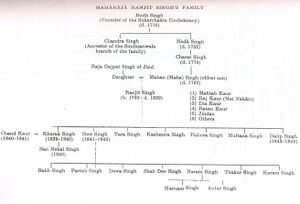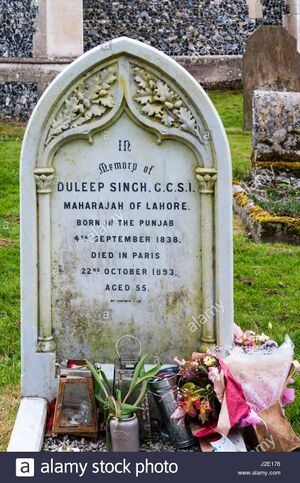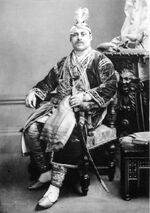Maharaja Dalip Singh
| Author:Laxman Burdak, IFS (R) |

Maharaja Dalip Singh (6.9.1838-20.10.1893) (महाराजा दिलीपसिंह) (also spelt as Duleep Singh) was the youngest son of Maharaja Ranjit Singh (Punjab) born of Maharani Jinda. He was the last Maharaja of the Sikh Empire.
His life
He was born on 6 September 1838 in Lahore. His mother, Maharani Jind Kaur, was one of the queens of Maharaja Ranjit Singh. He died in Paris on 12 October 1893. [1]
After the death of Maharaja Ranjit Singh in 1839, and after first Sikh war in 1843, Maharani Jind Kaur was exiled to Banaras by the Britishers. After some time, Dalip Singh was forcibly separated from his mother and was put into the care of Dr. John Login and sent to London where he received his education and spent rest of his life.
Koh-i-Noor
The world famous diamond Koh-i-Noor, was in his possession after the death of his father. Britishers confiscated the diamond, along with many treasures of late Maharaja Ranjit Singh.
His Family

Dalip's mother, Maharani Jinda, was in exile in Nepal. In 1860 he was allowed to return to India and he decided to bring his mother back to England. She died in England in 1863.
Dalip Singh married twice, first to Bamba Müller and then to Ada Douglas Wetherill. He had eight children in total, six from his first marriage to Bamba:
- Prince Victor Duleep Singh
- Prince Frederick Duleep Singh
- Prince Albert Edward Duleep Singh
- Princess Bamba Duleep Singh
- Princess Catherine Duleep Singh[24]
- Princess Sophia Duleep Singh
He also had two children from his second marriage to Ada Douglas Wetherill:
- Princess Pauline Alexandra Duleep Singh
- Princess Ada Irene Beryl Duleep Singh
All the eight children died without legitimate issue, ending the direct line of the Sikh Royalty.[2]
There is a memorial at Eton College in England to Princes Victor and Frederick, Maharajah Duleep Singh's two sons who studied at Eton in the 1870s.
Death
He died in Paris on 20.10.1893.[3]
The grave of Maharaja Dalip Singh of Lahore

The grave of Maharaja Dalip Singh of Lahore. (Elveden , London). On this day, the last king of the greatest empire of India died in Paris.He was the youngest son Sher E Punjab Maharaja Ranjit Singh.By the way, the Maharaja's entire life was spent in struggle.After his death according to his last wish, he should be cremated as per Sikh customs.But the British did not allow this to happen and according to the custom of the British, they were buried.But Kunwar Beant Singh Sandhawalia ji of Lahore from his family raised his voice many times in this regard, That their rites should be in accordance with Sikh customs.Even today, Kunwar Sukhdev Singh Sandhawalia, son of Kunwar Beant Singh Sandhawalia, is raising voice in this context. We sincerely hope that our Indian government takes some drastic step in this context.May the Maharaja's soul be at peace.[4]
लाहौर रियासत के महाराजा दलीप सिंह की कब्र। (एल्वेडन , लंदन): इस दिन, भारत के सबसे बड़े साम्राज्य के अंतिम राजा की पेरिस में मृत्यु हो गई थी। वह सबसे छोटे बेटे शेर ई पंजाब महाराजा रणजीत सिंह थे। वैसे, महाराजा का पूरा जीवन संघर्ष में बीता। उनकी मृत्यु के बाद उनकी अंतिम इच्छा के अनुसार , उनका सिख रीति रिवाजों के अनुसार अंतिम संस्कार किया जाना चाहिए। लेकिन अंग्रेजों ने ऐसा नहीं होने दिया और अंग्रेजों के रिवाज के अनुसार उन्हें दफनाया गया। लेकिन कुंवर बेअंत सिंह संधवलिया जी (जो लाहौर राजपरिवार से है)ने अपने परिवार से इस संबंध में कई बार आवाज उठाई थी, कि उनके संस्कार सिख रीति रिवाजों के अनुसार होने चाहिए। आज कुंवर बेअंत सिंह संधावलिया के पुत्र कुंवर सुखदेव सिंह संधावालिया इस संबंध में आवाज उठा रहे हैं। हमें पूरी उम्मीद है कि हमारी भारत सरकार इस संदर्भ में कुछ कठोर कदम उठाएगी। महाराजा की आत्मा को शांति मिले ।[5]
Read More about Maharaja Dalip Singh
Read More about Maharaja Dalip Singh at Jat History Thakur Deshraj/Chapter VII Part I (ii) (pp.379-400)
Film on Dalip Singh
A film titled, Maharaja Duleep Singh: A Monument Of Injustice was made in 2007, directed by P.S. Narula.
Duleep Singh in Frith's painting
1863 में Prince of Wales की शादी की पेंटिंग में लाहौर के महाराजा दलीप सिंह संधवलिया का चित्रित किया। क्वीन विक्टोरिया के बड़े बेटे और प्रिंस अल्बर्ट और डेनमार्क के राजकुमारी एलेक्जेंड्रा के राजकुमार की शादी सेंट जॉर्जेस चैपल, विंडोर में हुई। कलाकार ने उस क्षण को चित्रित किया है जब राजकुमार राजकुमारी उंगली पर अंगूठी रखने वाला है। पेंटिंग के शीर्ष दाहिने हिस्से में रानी खुद इस समारोह में नज़र आ रही हैं और इस दृश्य को स्केच किया है, लेकिन इस अवसर की आधिकारिक तस्वीरों और पेंटिंग में प्रमुख लोगों के साथ-साथ बैठने से भी काम किया है।
H.H Maharaja Duleep Singh Sandhawalia of Lahore featured in Frith's painting of the wedding of prince of Wales in 1863.
Duleep Singh’s son Victor Duleep Singh

The marriage of Maharaja Duleep Singh’s son Victor Duleep Singh into English aristocracy, to the daughter of the Earl of Coventry, was one of the consequences of this vague Jat/Geat/Jute connection.
The Maharaja was informed on many occasions that England too had once been settled by the Jutes, distant cousins of the Jat “race”. [This was in the very early stages of the Indo-European hypothesis, so understandable.]

It is interesting how confident English historians were about the Gete/Yuezhi/Jat connection, there is of course as I've said some truth to this, though not of direct lineal descent as they believed "to trace the connection of the blood of Kadphises in the veins of Ranjit Singh."
Source - https://twitter.com/sialmirzagoraya/status/1739579548700967370?s=20
Gallery
-
Bakshish Singh Sandhanwalia Haveli, It was built by Bakshish Singh Sandhanwalia between 1900-10 who was son of the Great Freedom Fighter Sardar Thakur Singh Sanhanwalia ( Cousin of Maharaja Duleep Singh Sandhawalia). Sardar Bakshish Singh Sandhawalia was adopted by Sardar Shamsher Singh Sandhanwalia. Credit:- Kunwar Damandeep Singh Sandhanwaliaji and Sardar Inderjit Singhji. Source - Jat Kshatriya Culture
External Links
Victoria & Albert Museum website.
Further reading
Jat History Thakur Deshraj: Pages 316-400
References
- ↑ Thakur Deshraj has written his date of birth as 4 September, and his date of death, as 20 October.
- ↑ The lives and times of three generations of India princesses. Edited by Peter Bance Navtej Sarna
- ↑ Jat History Thakur Deshraj/Chapter VII Part I (ii),p.400
- ↑ Jat Kshatriya Culture
- ↑ []
Back to The Rulers




